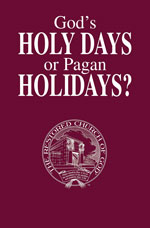Each year, as we progress through the seven annual feast days, we are reminded of Godâs overall purpose for mankind. Keeping these days helps us understand the reason we were born.
In early spring, we keep the Passover, the annual memorial of Christâs sacrifice, which makes possible the forgiveness of past sins and the opportunity for a completely new start. This is the first step in the plan of salvation.
Next, we celebrate the Days of Unleavened Bread, which picture Godâs people coming out of sin, as typed by ancient Israel leaving Egypt. This is the second step in Godâs Plan.
The next pivotal day in Godâs plan of salvation is Pentecost. Each year, as the Feast of Firstfruits approachesâa day which pictures the receiving of the Holy Spiritâyou must remember its significance in the process of overcoming sin.
(1) Did Christ promise His disciples that after His departure, He would send them spiritual help? John 14:16-18. Did Christ repeat this promise after His Resurrection? Luke 24:49; John 20:21-22; Acts 1:8. On what day did Christ send the Holy Spirit to His disciples? Acts 2:1-4.
Pentecost in AD 31 was the beginning of the New Testament Church of God. The disciples, who trained under Christ for three and a half years, received the Holy Spirit and began to fulfill their responsibilities as apostles.
This feast depicts the small early spring harvest, which typifies those called into the Church as firstfruits. Only a tiny minority are called now to fulfill special purposes in Godâs Plan. The vast majority of humanity will be called during the Millennium, and after the Second Resurrection at the end of Christâs 1,000-year reign.
(2) Was Pentecost commanded to be kept forever, just like Passover and the Days of Unleavened Bread? Leviticus 23:14, 21.
When God says âforever,â He means forever! We will see that the Holy Days will be observed in the coming Millennium. This is contrary to the opinions of critics who denounce them as temporary âJewish daysâ that were âdone away with.â
(3) Did the apostles come together in Jerusalem for the Day of Pentecost? Acts 2:1. Is there evidence that the Church in this era continued to keep Pentecost? Acts 20:16; I Corinthians 16:8.
Naturally, the apostles observed Pentecost, as they were among the many thousands of devout Jews who also assembled on that day.
This Holy Day is mentioned in two scriptures after the event recorded in Acts 2. In Acts 20:16, Luke recorded that Paul was determined to keep this feast in Jerusalem. In I Corinthians 16:8, Paul informs the Church at Corinth that he will stay in Ephesus until Pentecost. All the Holy Days were important milestones, and the apostles often used these days as benchmarks in time.
(4) How does the wave sheaf offering tie into Pentecost, and what does it signify about the meaning of the day? Leviticus 23:10-11; John 20:17; I Corinthians 15:20-23.
The seven annual Holy Days are tied to the two harvest seasons in the region of Judea. The first season is the small spring harvest, followed later by the larger fall harvest. The first harvest begins during the Days of Unleavened Bread and ends by the time of Pentecost, also called the Feast of Weeks. This name reflects how this feast is derived by counting seven Sabbaths, covering seven weeks. The Greek term for Pentecost means âfiftieth.â
Before the spring harvest began, the wave sheaf offering took place. This offering always occurred on the first day of the week, following the weekly Sabbath during the Days of Unleavened Bread. This wave sheaf offering of barley was the first of the firstfruits brought to the priest, to be presented before God. Barley was most often used for the wave sheaf offering, as it was the first grain to mature and be ready for harvest in early spring.
In John 20:17, Christ had already been resurrected and had first manifested Himself in human form to Mary Magdalene. Note that He had not yet ascended to the Father, but had revealed Himself to Mary (vs. 1, 11). He indicated that she could not touch Him at that particular time, because He had not yet ascended to the Father.
(5) Were the disciples permitted to touch Christ later that same day? Matthew 28:9.
The disciples were allowed to touch Christ, which meant the Father had accepted Him by that time. As a Spirit Being, Christ had ascended to heaven and returned instantaneously after He had been accepted. As the fulfillment of the wave sheaf offering, He was accepted on the first day of the week (John 20:19), just as the wave sheaf was always offered and accepted on that same day (Lev. 23:11).
We have already seen that the wave sheaf offering depicts the beginning of the small spring harvest, which represents those few now being called as firstfruits. Now we need to understand how Pentecost was counted to understand its correct date each year.
(6) What day was the wave sheaf offering made each year? Leviticus 23:10-11.
âThe morrow after the Sabbathâ means the first day of the week, or Sunday. The context of this verse falls within the time frame of the Days of Unleavened Bread, as verse 8 summarizes the seven days and states that the seventh day is a time of holy convocation. The Sabbath referred to in verse 11 could only be the weekly Sabbath that falls within the Days of Unleavened Bread. If it were counted from either one of the Holy Days (first or seventh), then Pentecost would always fall on the same day of the month year after year and would not have to be counted.
(7) How was the count made from the day of the wave sheaf offering? Leviticus 23:15-16.
We are to begin counting on the first day of the week after the Sabbath of the wave sheaf offering. The target day is clearly stated in verse 16, which shows that we are to number âeven unto the day after the seventh Sabbath,â or seven weeks.
(8) How will the 12 apostles serve in the coming kingdom of God? Matthew 19:28. Are those called in this age qualifying to rule over cities? Luke 19:12-19. Are those called in this age destined to judge the world and even angels in the future? I Corinthians 6:2-3. Will Godâs faithful servants reign in the kingdom of God as kings and priests? Revelation 5:10.
Those whom God is calling now are preparing to serve in the kingdom of God as teachers and instructors, kings and priests. We are given a great opportunity today through our calling.
(9) Why do even highly educated people in the world have difficulty understanding Scripture and fail to grasp its true meaning? Isaiah 28:9-13; Matthew 13:10-16. Do we find the vast majority of humanity in a state of blindness in this age? II Corinthians 2:14, 4:4; Romans 11:7.
Only those with whom Christ is working can have their minds opened to the truth. The rest remain blind until the time when God will begin to work with them. Read Romans 11:26, 29-33 and II Peter 3:9.
(10) Why are those called out of the world in this age known as firstfruits? James 1:18; Revelation 14:4. Do we find brethren being referred to as firstfruits in Scripture? Romans 16:5; I Corinthians 16:15.
The small spring harvest of the firstfruits did not begin until the high priest presented the wave sheaf offering (the first of the firstfruits) for God to accept. Likewise, the harvest of the firstfruits in Godâs Plan did not begin until Christ was accepted as the First of the Firstfruits. This small harvest of the firstfruits will not take place until the Return of Christ.
(11) What is the meaning of the two loaves of bread offered at the Feast of Firstfruits? Leviticus 23:17.
The two loaves of bread represent the times of the Old Testament Church and the times of the New Testament Church (called-out ones). One loaf portrays ancient Israel, and the other loaf portrays the true Church. The fact that both loaves contained leavening shows that even those called after the time of Christ are in the process of overcoming sin and developing character.
God gave the Ten Commandments from Mount Sinai on the Feast of Pentecost. Although the Law was written in stone at that time (Ex. 31:18), those whom God calls into His Church are to have the Law written in their hearts (Jer. 31:33). This is made possible through the power of the Holy Spirit, which was given to the Church of God on Pentecost.
















